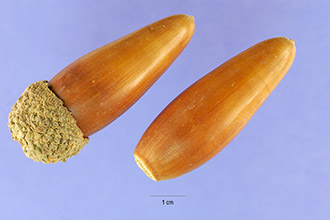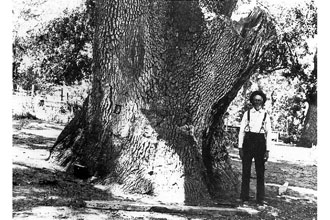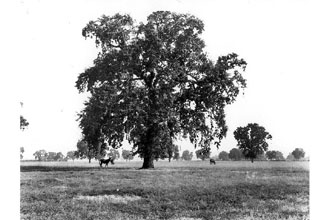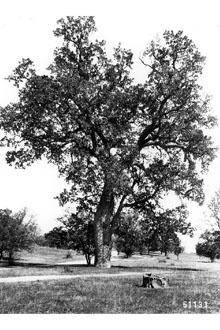Quercus lobata Née var. turbinata Jeps.
Scientific Name: Quercus lobata Née var. turbinata Jeps.

| General Information | |
|---|---|
| Usda Symbol | QULOT |
| Group | Dicot |
| Life Cycle | Perennial |
| Growth Habits | Tree |
| Native Locations | QULOT |
Plant Guide
Uses
General: White oak is a dominant species of valley oak savanna and low elevation riparian forests in California, providing a critical habitat for many animal and plant species, stabilizing soils in flood plains, and contributing an aesthetic value to the natural landscape. Wildlife: California white oak acorns are an important food source for deer, California ground squirrels, band-tailed pigeons, and acorn woodpeckers. Ethnobotanic: Native Americans used acorns as a food staple. Economic: White oak was a source of timber by early settlers. However, because older trees are especially susceptible to fungal decay, their wood was not widely preferred.
Status
Please consult the PLANTS Web site and your State Department of Natural Resources for this plant’s current status, such as, state noxious status and wetland indicator values.
Description
General: Oak Family (Fagaceae). California white oak, sometimes referred to as valley oak, is a deciduous tree, 12 to 30 m tall, with a rounded spreading crown. The mature bark is gray, scaly, and often vertically fissured in a checker-like pattern. Leaves are oblong to obovate, 5 to 10 cm long, with 7 to 11 deep lobes. The upper surface is green and shiny; the lower surface is grayish green. Like all oaks, white oak is monoecious and wind-pollinated. The acorn cups are composed of thick, tubercled scales. The one-seeded nuts are 3 to 5 cm long, oblong to ovoid, and mature in one year. Flowering takes place from March to April. Fruits mature between August and October. Good acorn production has been reported to occur annually, but high acorn numbers occur episodically. Trees of this species may be among the largest oaks in North America. Gary A. Monroe @ PLANTS
Distribution
Although once widespread in much of the northern Great Central Valley of California, California white oak now occurs primarily in the inner Coast Ranges and bordering foothills, Use soil moisture sensors to measure the soil moisture of Quercus lobata Née var. turbinata Jeps.., For current distribution, please consult the Plant Profile page for this species on the PLANTS Web site,
Establishment
Adaptation: It grows in deep, fertile soils of flats and bottomlands below 1200 m. The climate is typically dry and hot, especially during the summer, with an average rainfall of 15 to 40 inches. Like most oaks, California white oak has an obligate relationship with mycorrhizal fungi, which provide critical moisture and nutrients. Some common associates in riparian habitats include coast live oak, sycamore, and cottonwoods, but sedges, grasses, and other herbaceous species are the dominant understory elsewhere. Propagation by Seed: Oak seeds do not store well and consequently seeds should be planted soon after maturity. Nuts are considered ripe when they separate freely from the acorn cap and fall from the tree. Care should be taken to collect local fruits, because they may be adapted to local environmental conditions. Viable nuts are green to brown and have unblemished walls. Nuts with discoloration or sticky exudates, and small holes caused by insect larvae, should be discarded. Direct Seeding: Unlike most other western oaks, white oak seeds germinate immediately following the first rains. Consequently, seeds should be planted soon after harvest to ensure establishment. Once a site is chosen, prepare holes that are 10 inches in diameter and 4 to 5 inches deep. One gram of a slow-release fertilizer should be placed in the bottom and covered by a small amount of soil. Place 6 to 10 acorns in each hole at a depth of 1 to 2 inches. Rodents or birds should use temporary enclosures to minimize herbivory. A simple enclosure can be constructed from a 1-quart plastic dairy container with the bottom removed and a metal screen attached. Near the end of the first season, seedlings should be thinned to 2 or 3 per hole and to 1 seedling by the second season. Supplemental watering may be necessary if a drought of 6 weeks or more occurs during the spring. Container Planting: Seeds may be planted in one-gallon containers, using well-drained potting soil that includes slow-release fertilizer. Tapered plastic planting tubes, with a volume of 10 cubic inches, also may be used. Seeds should be planted 1 to 2 inches deep and the soil kept moist. Seedlings should be transplanted as soon as the first true leaves mature. Planting holes should be at least twice as wide and deep as the container. Seedlings may require watering every 2 to 3 weeks during the first season. Care should be taken to weed and mulch around young plants until they are 6 to 10 inches tall.
Management
General: Based on historic records, valley oak woodland has declined as a result of woodcutting, agriculture, and urban development, primarily in the Great Central Valley of California and in foothill bottomlands. Seedlings are especially sensitive to trampling and herbivory by cattle. Mature trees are susceptible to oak crown and root rot fungi (e.g., Inonotus, Ganoderma, and Laetiporus), that decay wood in trunks and roots. Consequently, activities that disturb or compact soil around trees, including construction and livestock grazing, need to be avoided or carefully managed within or near the zone of leaf canopy. Cultivars, Improved and Selected Materials (and area of origin) It is best to plant species from your local area, adapted to the specific site conditions where the plants are to be grown. Available from most native plant nurseries within its range. Contact your local Natural Resources Conservation Service (formerly Soil Conservation Service) office for more information. Look in the phone book under ”United States Government.” The Natural Resources Conservation Service will be listed under the subheading “Department of Agriculture.”
Plant Traits
Growth Requirements
| Temperature, Minimum (°F) | 7 |
|---|---|
| Adapted to Coarse Textured Soils | Yes |
| Adapted to Fine Textured Soils | No |
| Adapted to Medium Textured Soils | Yes |
| Anaerobic Tolerance | None |
| CaCO3 Tolerance | None |
| Cold Stratification Required | No |
| Drought Tolerance | Medium |
| Fertility Requirement | Medium |
| Fire Tolerance | Low |
| Frost Free Days, Minimum | 200 |
| Hedge Tolerance | None |
| Moisture Use | Medium |
| pH, Maximum | 7.5 |
| pH, Minimum | 4.5 |
| Planting Density per Acre, Maxim | 800 |
| Planting Density per Acre, Minim | 300 |
| Precipitation, Maximum | 40 |
| Precipitation, Minimum | 16 |
| Root Depth, Minimum (inches) | 42 |
| Salinity Tolerance | None |
| Shade Tolerance | Intolerant |
Morphology/Physiology
| Bloat | None |
|---|---|
| Toxicity | None |
| Resprout Ability | Yes |
| Shape and Orientation | Rounded |
| Active Growth Period | Spring and Summer |
| C:N Ratio | High |
| Coppice Potential | No |
| Fall Conspicuous | Yes |
| Fire Resistant | No |
| Flower Color | Yellow |
| Flower Conspicuous | No |
| Foliage Color | Green |
| Foliage Porosity Summer | Dense |
| Foliage Porosity Winter | Porous |
| Foliage Texture | Medium |
| Fruit/Seed Conspicuous | Yes |
| Nitrogen Fixation | None |
| Low Growing Grass | No |
| Lifespan | Moderate |
| Leaf Retention | No |
| Known Allelopath | No |
| Height, Mature (feet) | 100.0 |
| Height at 20 Years, Maximum (fee | 35 |
| Growth Rate | Rapid |
| Growth Form | Single Crown |
| Fruit/Seed Color | Brown |
Reproduction
| Vegetative Spread Rate | None |
|---|---|
| Small Grain | No |
| Seedling Vigor | Medium |
| Seed Spread Rate | Slow |
| Fruit/Seed Period End | Fall |
| Seed per Pound | 69 |
| Propagated by Tubers | No |
| Propagated by Sprigs | No |
| Propagated by Sod | No |
| Propagated by Seed | Yes |
| Propagated by Corm | No |
| Propagated by Container | Yes |
| Propagated by Bulb | No |
| Propagated by Bare Root | Yes |
| Fruit/Seed Persistence | No |
| Fruit/Seed Period Begin | Summer |
| Fruit/Seed Abundance | Medium |
| Commercial Availability | Contracting Only |
| Bloom Period | Early Spring |
| Propagated by Cuttings | No |
Suitability/Use
| Veneer Product | No |
|---|---|
| Pulpwood Product | No |
| Protein Potential | Low |
| Post Product | No |
| Palatable Human | No |
| Palatable Browse Animal | Low |
| Nursery Stock Product | Yes |
| Naval Store Product | No |
| Lumber Product | No |
| Fuelwood Product | High |
| Fodder Product | No |
| Christmas Tree Product | No |
| Berry/Nut/Seed Product | No |




